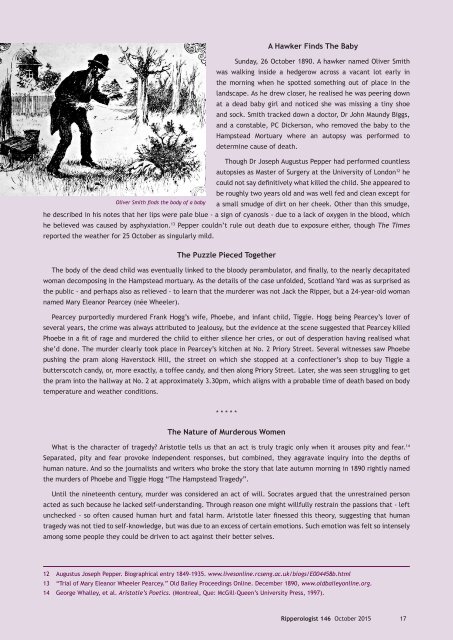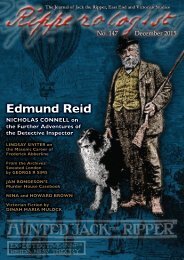GEORGE HUTCHINSON
orxwju5
orxwju5
You also want an ePaper? Increase the reach of your titles
YUMPU automatically turns print PDFs into web optimized ePapers that Google loves.
Oliver Smith finds the body of a baby<br />
A Hawker Finds The Baby<br />
Sunday, 26 October 1890. A hawker named Oliver Smith<br />
was walking inside a hedgerow across a vacant lot early in<br />
the morning when he spotted something out of place in the<br />
landscape. As he drew closer, he realised he was peering down<br />
at a dead baby girl and noticed she was missing a tiny shoe<br />
and sock. Smith tracked down a doctor, Dr John Maundy Biggs,<br />
and a constable, PC Dickerson, who removed the baby to the<br />
Hampstead Mortuary where an autopsy was performed to<br />
determine cause of death.<br />
Though Dr Joseph Augustus Pepper had performed countless<br />
autopsies as Master of Surgery at the University of London 12 he<br />
could not say definitively what killed the child. She appeared to<br />
be roughly two years old and was well fed and clean except for<br />
a small smudge of dirt on her cheek. Other than this smudge,<br />
he described in his notes that her lips were pale blue - a sign of cyanosis - due to a lack of oxygen in the blood, which<br />
he believed was caused by asphyxiation. 13 Pepper couldn’t rule out death due to exposure either, though The Times<br />
reported the weather for 25 October as singularly mild.<br />
The Puzzle Pieced Together<br />
The body of the dead child was eventually linked to the bloody perambulator, and finally, to the nearly decapitated<br />
woman decomposing in the Hampstead mortuary. As the details of the case unfolded, Scotland Yard was as surprised as<br />
the public - and perhaps also as relieved - to learn that the murderer was not Jack the Ripper, but a 24-year-old woman<br />
named Mary Eleanor Pearcey (née Wheeler).<br />
Pearcey purportedly murdered Frank Hogg’s wife, Phoebe, and infant child, Tiggie. Hogg being Pearcey’s lover of<br />
several years, the crime was always attributed to jealousy, but the evidence at the scene suggested that Pearcey killed<br />
Phoebe in a fit of rage and murdered the child to either silence her cries, or out of desperation having realised what<br />
she’d done. The murder clearly took place in Pearcey’s kitchen at No. 2 Priory Street. Several witnesses saw Phoebe<br />
pushing the pram along Haverstock Hill, the street on which she stopped at a confectioner’s shop to buy Tiggie a<br />
butterscotch candy, or, more exactly, a toffee candy, and then along Priory Street. Later, she was seen struggling to get<br />
the pram into the hallway at No. 2 at approximately 3.30pm, which aligns with a probable time of death based on body<br />
temperature and weather conditions.<br />
* * * * *<br />
The Nature of Murderous Women<br />
What is the character of tragedy? Aristotle tells us that an act is truly tragic only when it arouses pity and fear. 14<br />
Separated, pity and fear provoke independent responses, but combined, they aggravate inquiry into the depths of<br />
human nature. And so the journalists and writers who broke the story that late autumn morning in 1890 rightly named<br />
the murders of Phoebe and Tiggie Hogg “The Hampstead Tragedy”.<br />
Until the nineteenth century, murder was considered an act of will. Socrates argued that the unrestrained person<br />
acted as such because he lacked self-understanding. Through reason one might willfully restrain the passions that - left<br />
unchecked - so often caused human hurt and fatal harm. Aristotle later finessed this theory, suggesting that human<br />
tragedy was not tied to self-knowledge, but was due to an excess of certain emotions. Such emotion was felt so intensely<br />
among some people they could be driven to act against their better selves.<br />
12 Augustus Joseph Pepper. Biographical entry 1849-1935. www.livesonline.rcseng.ac.uk/biogs/E004458b.html<br />
13 “Trial of Mary Eleanor Wheeler Pearcey.” Old Bailey Proceedings Online. December 1890, www.oldbaileyonline.org.<br />
14 George Whalley, et al. Aristotle’s Poetics. (Montreal, Que: McGill-Queen’s University Press, 1997).<br />
Ripperologist 146 October 2015 17




